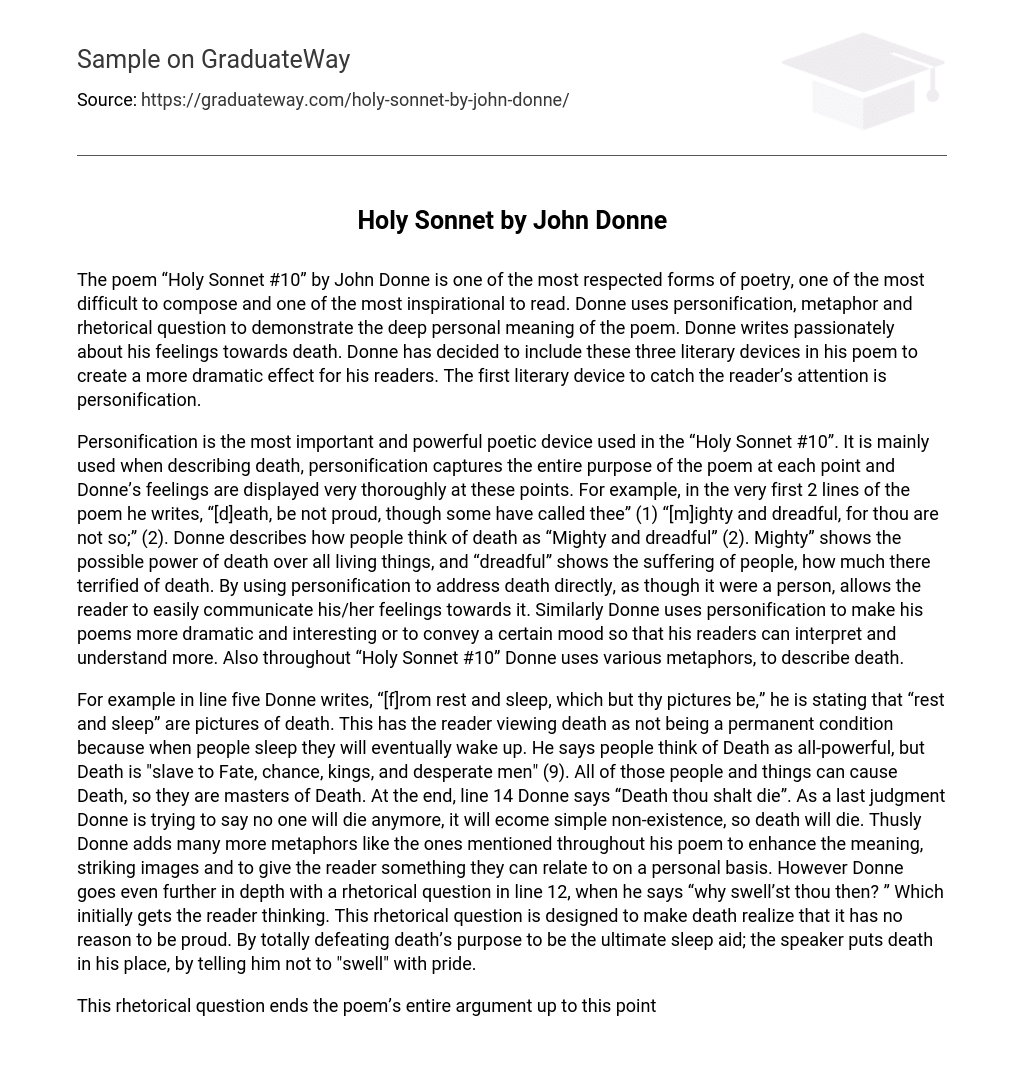The poem “Holy Sonnet #10” by John Donne is one of the most respected forms of poetry, one of the most difficult to compose and one of the most inspirational to read. Donne uses personification, metaphor and rhetorical question to demonstrate the deep personal meaning of the poem. Donne writes passionately about his feelings towards death. Donne has decided to include these three literary devices in his poem to create a more dramatic effect for his readers. The first literary device to catch the reader’s attention is personification.
Personification is the most important and powerful poetic device used in the “Holy Sonnet #10”. It is mainly used when describing death, personification captures the entire purpose of the poem at each point and Donne’s feelings are displayed very thoroughly at these points. For example, in the very first 2 lines of the poem he writes, “[d]eath, be not proud, though some have called thee” (1) “[m]ighty and dreadful, for thou are not so;” (2). Donne describes how people think of death as “Mighty and dreadful” (2). Mighty” shows the possible power of death over all living things, and “dreadful” shows the suffering of people, how much there terrified of death. By using personification to address death directly, as though it were a person, allows the reader to easily communicate his/her feelings towards it. Similarly Donne uses personification to make his poems more dramatic and interesting or to convey a certain mood so that his readers can interpret and understand more. Also throughout “Holy Sonnet #10” Donne uses various metaphors, to describe death.
For example in line five Donne writes, “[f]rom rest and sleep, which but thy pictures be,” he is stating that “rest and sleep” are pictures of death. This has the reader viewing death as not being a permanent condition because when people sleep they will eventually wake up. He says people think of Death as all-powerful, but Death is “slave to Fate, chance, kings, and desperate men” (9). All of those people and things can cause Death, so they are masters of Death. At the end, line 14 Donne says “Death thou shalt die”. As a last judgment Donne is trying to say no one will die anymore, it will ecome simple non-existence, so death will die. Thusly Donne adds many more metaphors like the ones mentioned throughout his poem to enhance the meaning, striking images and to give the reader something they can relate to on a personal basis. However Donne goes even further in depth with a rhetorical question in line 12, when he says “why swell’st thou then? ” Which initially gets the reader thinking. This rhetorical question is designed to make death realize that it has no reason to be proud. By totally defeating death’s purpose to be the ultimate sleep aid; the speaker puts death in his place, by telling him not to “swell” with pride.
This rhetorical question ends the poem’s entire argument up to this point. Alternatively this very powerful statement demonstrates John Donne’s belief that life after death will ultimately be the downfall of death, and that death can die as easily as any man or woman. By using this rhetorical question, Donne directs the listener’s thoughts to a question they hadn’t considered, and also a question that has only one sensible answer, which is the answer the writer wanted. In the end certain rhetorical questions like this one, gets the reader to focus back on the meaning of the poem.
In conclusion, Donne uses these literary devices such as personification to make a more dramatic effect on his readers, to make the poem seem more interesting and down to earth with the human characteristics he puts on death. Similarly Donne’s metaphors, makes a person that is not educated, understand his work much better because of the striking images he puts into them. Lastly he leaves the reader thinking with a rhetorical question, which gets the reader more interested in the poem. Therefore all three literary devices sum up the meaning and get the readers attention right where Donne wants it.





